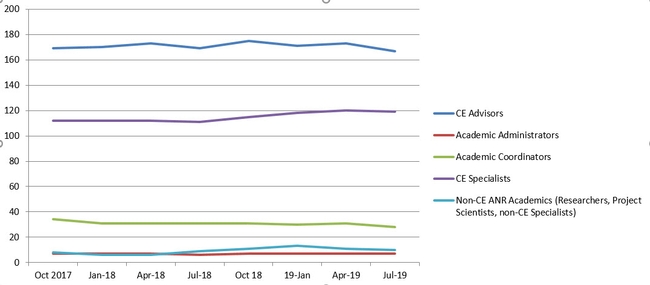The academic footprint numbers, ending June 30, 2019, are available. It's not good news, though it is not surprising either. Every June, we have a dip in numbers of academics because there is a financial benefit to retiring at the end of June. The benefit is related to receiving any base scale increase and that increase becoming part of one's pension calculation. I don't pretend to understand it fully. What I do understand is that for the past few years, we have regained the academic numbers shortly after July 1 as hiring has continued. This year, however, we have slowed hiring, so I suspect numbers will continue to dip a bit before we reverse course into an upswing. Fortunately, that upswing is near. We continue to fill positions from the 2016 position call. And, we anticipate the release of a few positions around the first of the calendar year. This should allow us to get ahead of June 2020's retirement dip. A few Academic Coordinator positions, vacated since June, are under recruitment, which should bring those numbers back up soon.
Recently I was asked why we automatically backfill staff positions but not academic positions. The answer isn't brief, but here it is. The approach to staffing for the two categories of jobs is fundamentally different. The CE Specialist and CE Advisor positions are filled through a consultative process with stakeholders ranging from clientele to partners to colleagues. Consideration of future programmatic needs drives the process. That look into the future is for several years because positions identified through this process come with a long-term commitment to the specialized program area (indefinite status). The result is a process that takes months to complete to secure the insights of the various groups consulted. The outcome is an opportunity to use collective wisdom to direct program priorities.
Other academic positions (i.e., academic coordinators, academic administrators) require approval to hire. These positions do not include eligibility for indefinite status and are often, but not always, soft-funded (grants, partners, non-permanent funds). It can take days, weeks, and occasionally months to receive approval to fill these positions. The consultative process is far more limited and includes the direct supervisor and perhaps a vice provost and/or associate vice president/vice president. Similarly, unit leaders for the business and support units also request to fill staff position vacancies. There is no automatic backfilling. Quite often, the position is within the unit's approved staffing plan that has undergone a rigorous review before approval by an associate vice president/president. These positions are not eligible for indefinite status, and the staffing plan can change from time to time, meaning that personnel needs change as well.
Perhaps refilling processes are not differentiated by academic or staff, but rather by eligibility for indefinite status. It's the indefinite appointment and commitment to the specialized program expertise that necessitates the extensive consultation.
